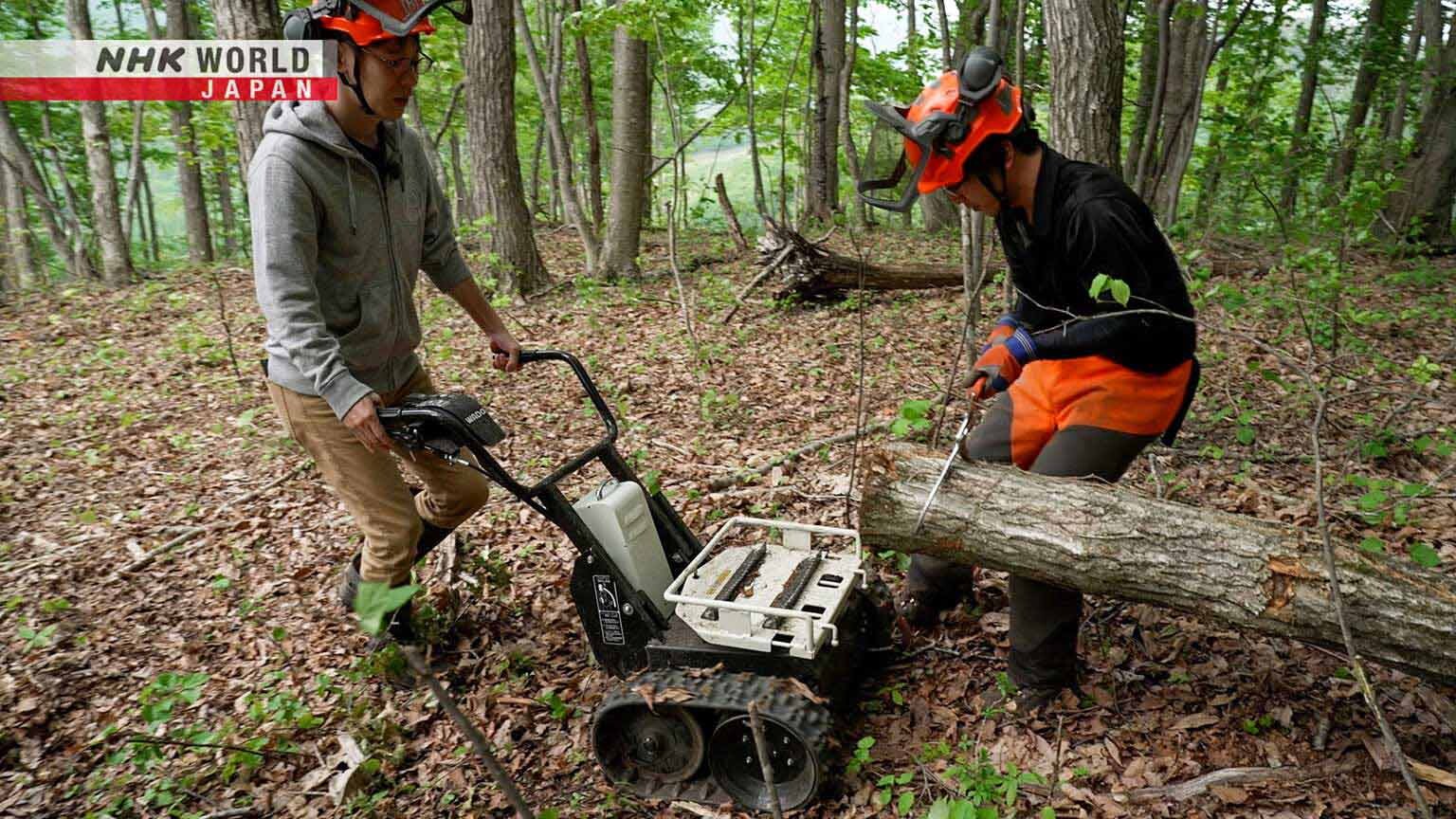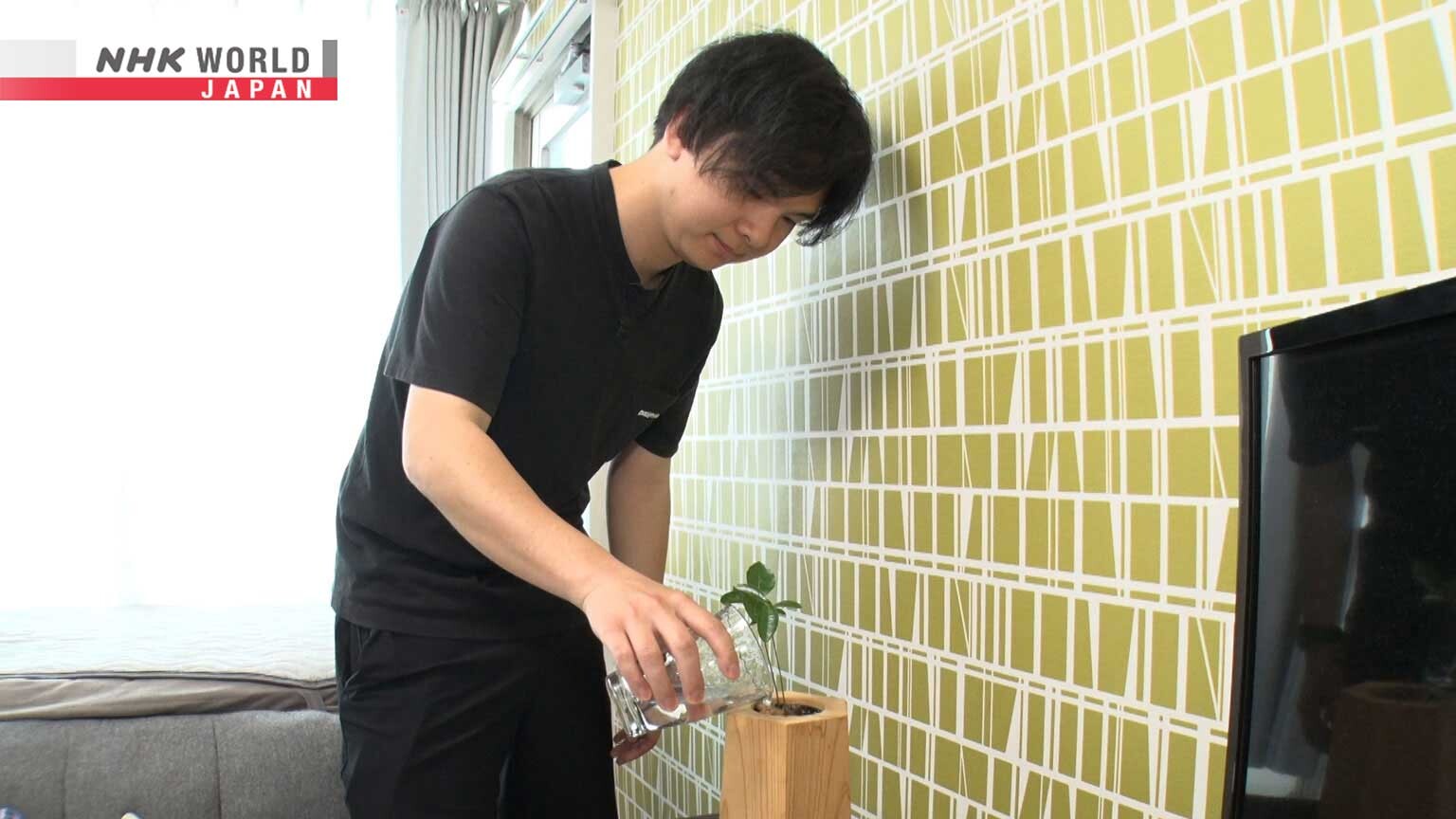Making Forestry More User-Friendly
[On-Site Report: Making Forestry More User-Friendly]
This episode features a tool designed to offer a simple and safe way to remove timber from steep slopes and a company that is making it easier for average people to get involved in reforestation.
*Subtitles and transcripts are available for video segments when viewed on our website.
On-Site Report: Making Forestry More User-Friendly


Global Trends: Forget the Shower? High-Tech Wants to Change How We Wash
Futuristic technology is rapidly changing how we live. Could the next frontier be the shower room with high-tech machines that wash humans? It's an idea that could also change nursing care for the elderly.


In Focus: Former Central Bank Chief Urges Different Growth Path for India
Fast-growing India is about to start a new chapter as the country's leader begins a historic third term in office. A former governor of India's central bank says some fresh ideas are needed to address a key challenge: generating jobs for the younger generation.
Transcript
India's economy grew at a robust 8.2 percent pace in the fiscal year through March.
Its strength stems from a population of 1.4 billion people,
the world's largest, with an average age of only 28.
The bad news... job creation is not keeping pace.
Many young people are struggling to find work.
Raghuram Rajan is a former chief of India's central bank.
He says tapping the population dividend is critical for the economy to grow at an even faster pace.
I think the key question for India is can it employ all the people coming into the labor force,
and if it can do that, it would generate a growth rate, which is somewhat stronger than what we have today,
and maybe push it up to 7,8,9 percent on a regular basis.
The country is trying to expand the job base through the so-called "Make in India" initiative.
It's a centerpiece of Prime Minister Modi's economic policy to foster manufacturing industries,
which are typically labor intensive.
Using low-cost and abundant manufacturing labor is a path
that China and other countries took in their early stages of economic development.
But Rajan says this model does not fit with India's current circumstances
and the competition it faces.
India is not competing with the West or with Japan,
it is competing with China, which still has many poor workers.
In the western provinces, it is competing with Vietnam, it is competing with Bangladesh.
And that's much in that competition, cheap labor, everybody has cheap labor,
it doesn't work that way.
Indeed, the statistics show that despite the "Make in India" strategy,
manufacturing has failed to make headway as a percentage of India's GDP.
Meantime, the services sector keeps expanding.
Rajan says it is in these services where India needs to focus its job creation initiatives...
training engineers, lawyers and programmers who have the skills global companies are looking for.
India should try to get more of the highly skilled services exports,
that will be the leading edge of the economy.
And to emphasize, you know, high skilled, high capital intensive manufacturing,
as the leading sector may imply a waste of resources, when in fact, high skill services are more suitable.
India doesn't have chip manufacturing,
but is now thinking of imitating the West by investing in chip manufacturing.
But it's going to be many generations behind the frontier.
And this is tremendously capital intensive, as you know.
So even $10 billion will not buy you a chip plant, you need more.
And so would it make more sense for India to invest in educating a lot more people
to bring them up to the highly skilled worker status?
The International Monetary Fund says India is forecast to become the world's 3rd largest economy in 2027,
overtaking Japan and Germany.
Rajan says if the country can focus on raising the skill sets of its biggest asset,
the huge and young population, it will become a stronger engine for the global economy.
A model of a human washing machine is on display at a company showroom in Osaka City.
The company Chairman Aoyama Yasuaki says the model is inspired
by a device he saw at the Osaka Expo when he was a child.
It will wash you completely clean from your head to your toes.
The model is based on a technology that creates extremely small water bubbles and doesn't use soap.
I can draw a line on my hand with a marker pen.
The bubbles are able to absorb the line from the body and wash it off.
Using this technology,
the company says its human washing machine can clean and dry the whole body in 15 minutes.
Other ideas are in the works to upgrade the device.
It shows people feeling well and relaxed.
The company is working with Osaka University to introduce sensors
to measure the pulse and add other health management functions.
The human washing machine with health management abilities is scheduled to be on show at the World Expo 2025,
which opens in Osaka in April.
I plan to propose new ways and means to wash the body.
I hope to use the Expo as an opportunity to spread this technology to the rest of the world.
The idea of using technology and machines to clean the body is finding uses in elderly care.
Let's take a bath while lying down.
This device was introduced on a trial basis at this elderly care home in April.
The residents' bodies are washed with hot water and special body soap.
It uses one liter of water to wash an entire body but leaves no water behind.
Here is the trick.
The center of the washer head releases hot water and soap to be rubbed across the body.
But at the same time, the water is sucked off the body by a vacuum cleaner function.
Kamei Ryuhei is president of the company that developed the product.
He had the experience of caring for his aging parents
and decided he wanted to develop a device to help people working with the elderly.
It removes the need to move elderly people.
I think it is a big advantage to be able to wash them while they are lying down.
With this machine, it takes only one staff member to wash an elderly patient with minor infirmities.
It improves the working environment for employees, so we'd like to continue using it.
We are receiving many inquiries about the device.
People working in the nursing care industry are typically very busy.
This specialized device can help reduce the working burden and save lots of time.
The emergence of machines to wash humans may come
to offer convenience and healthcare options in the home.
But the 50-year-old idea looks to be also giving rise to timely devices for nursing care in Japan,
where the population is rapidly aging.
A small machine that makes transporting logs alone or in small groups safer and easier.
And a tree-planting venture that is replanting Japan's forests
with seedlings grown in homes and offices.
Today's On-Site Report features companies that are trying to make it easier
for average people to be involved in restoring and maintaining Japan's forests.
This lush deciduous forest can be found in eastern Gunma prefecture.
Several decades ago,
logs from this forest were harvested and used for growing shiitake mushrooms.
Decreased demand led to the forest being left abandoned.
According to the land owners, it had sat untouched for nearly three decades.
However, in recent years,
a volunteer group of local citizens has been coming to do maintenance work here twice a month.
Today, the 10-person group is being led by two forestry professionals.
With skilled volunteers hard to find,
the group relies on amateurs who are willing to learn on the job!
Today, the group plans to fell several old oak and chestnut trees.
While cutting them down requires skill,
the most challenging task for the group is removal.
Usually, felled trees are cut into smaller, more manageable sized logs.
Even then, they can weigh up to 60 kg,
and often have to be rolled down steep hillsides to get them to the nearest access trail.
The rugged and unpredictable terrain makes controlling where they will go impossible.
Look out, look out!
This means the work isn't just exhausting, it's hazardous.
The logs are then loaded onto a crawler carrier
and transported to a collection point where a larger truck is standing by.
To reduce the risk and lessen the burden involved,
today, the team began using a unique new type of logging tool.
A small, electric motor-powered log mover that uses caterpillar tracks to navigate rugged slopes.
One end of the log is placed onto the metal gripping spikes
and then is synched down to secure it.
An entire log can be transported without needing to be cut into smaller pieces.
Nice, nice, you're doing great!
This 150kg, 8-meter-long log was easily handled by just one person.
Pretty amazing, right?
Not knowing much about this kind of work,
I always viewed forestry as being quite dangerous.
But with a tool like this,
you can load up much larger logs and still move them safely and easily,
so I think it really reduces the barriers that prevent a lot of people form trying this kind of work.
Dubbed "the mountain cat,"
the tool was developed by the 4th generation owner of a lumber company, Otomo Yasuhiro.
He believes one of the main reasons why more of Japan's forests
aren't being tapped for their timber resources is the high cost of transportation.
Industry experts estimate that cutting and transporting logs
accounts for about 60% of the market price for domestic timber
and much of that goes to building and maintaining logging roads.
Getting timber out of Japan's rugged terrain can only be done
with expensive equipment and specially designed vehicles.
So that means only skilled professionals from established companies are able to do that sort of work here.
To create a tool that anyone could use safely and easily,
Otomo took a standard snow blower and heavily modified it.
Its compact design also means it can be stored and transported quite easily.
He hopes his new tool will make it possible for average people
to get involved in the timber industry by giving them a practical and accessible way
of doing removal and transportation work.
I hope it makes some people think,
Why not give it a try and make some money?
That could lead to creating a new type of side business
that will get more people involved in our industry.
These foothills in southern Wakayama prefecture are being replanted
after sitting untouched and uncared-for for over a decade.
A local forestry association has come with approximately 1,400 tree seedlings
including oak, cherry, and a few other species.
Employees from a local bank have joined them to plant oak seedlings
that they have been growing themselves over the last year.
I want it to grow up to be strong and healthy.
It so cute!
I'm sad it won't be around anymore, but I really hope it thrives out here!
The seedlings were originally sold as part of a "cultivation kit."
A large kit marketed toward businesses that contains 24 potted seedlings
sells for about $2,700.
While a seed-based kit for individuals, is priced at about $80.
After taking care of and growing the seedlings for 1-2 years,
customers are encouraged to plant them in areas designated for reforestation.
The service was dreamt up by Okugawa Tokika, the founder of a local tree-planting company.
She was inspired to do something,
after a powerful typhoon triggered damaging mudslides in Wakayama back in 2011.
It was determined that a bare hillside that hadn't been replanted
after harvesting contributed to the severity of the slides.
When that happened, I felt called to figure out ways to prevent or reduce landslides.
To achieve her goal, Okugawa partnered with forestry expert, Ohtani Eitoku.
Property owners of mountainous forest land in Japan are often reluctant to plant trees.
This is because the initial cost is high and it can take several decades
before the timber can be harvested and sold.
Planting a large amount of trees costs quite a bit of money.
If someone said, "it's going to cost you upwards of $10,000 and you will have to wait a long time
before you have any chance at seeing a return on your investment,"
- how many people do you think are going to say yes to that?
Ohtani feels the best way to turn things around
and get Japan's mountains and forests back to being healthy again,
is by getting the general public actively involved.
Growing trees isn't something most of us do in our daily lives.
We hope that our tree-planting kits will help people to realize how hard taking care of trees can be
as well as feel the joy of seeing them sprout and grow.
Hopefully this type of experience will also lead them to becoming interested
in taking care of our mountains, forests, and other natural resources.
IT consultant Dan Shota purchased a tree-growing kit several months ago.
After taking care of his tree for about 3 months,
he says the experience is already worth more than the $80 price tag.
I had no idea that seedlings could sprout from acorns!
Considering this will be an enriching 2-year-long experience for me,
I don't think it's expensive at all.
I hope to learn more about forestry and contribute a little to supporting the people
who are dedicated to taking care of our mountains and forests.
Getting people interested in forestry and willing to help us try
and solve at least one problem is very important and could have positive impacts
on the forestry industry as well as disaster prevention.